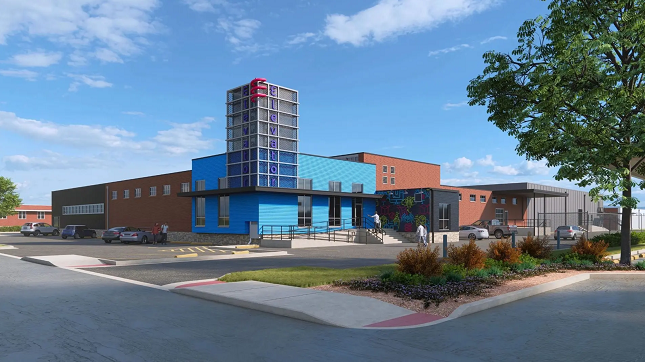It’s a crisp Tuesday morning in October when I pull up to a nondescript building in North Kansas City, just off Armour Road. Across the street, the folks at Callsign Brewing are already prepping for the day, and I can smell the faint aroma of hops in the air. This unassuming location, sandwiched between the brewery and the railroad tracks that have defined NKC for generations, doesn’t look revolutionary from the outside. But inside, a concept is taking shape that could fundamentally alter how hundreds of local small businesses operate.
Welcome to the world of co-warehousing. If you haven’t heard the term yet, you’re not alone. But if Shannon and Emiliano Lerda have their way, it’ll soon become as familiar to entrepreneurs as “co-working” was a decade ago.
The Home Office Dilemma: When Success Becomes a Storage Problem
Amanda Richardson laughs as she shows me photos on her phone. “This was my living room last Christmas,” she says, pointing to an image where towers of cardboard boxes form a maze around her couch. A small decorated tree is barely visible behind stacks of shipping materials. “And this,” she continues, swiping to another photo, “was my dining room table. Or what was left of it.”
Richardson, 37, runs BalanceBox KC, a subscription box service featuring locally-sourced wellness products. When her boxes were featured in a popular lifestyle blog last year, sales quadrupled almost overnight. What started as a side hustle quickly snowballed into a logistical nightmare.
“I was stepping over inventory to get to my coffee maker,” Richardson tells me, shaking her head. “My husband started calling our garage ‘the warehouse district.’ I was growing, sure, but my home was disappearing around me.”
Richardson isn’t alone. According to a 2024 survey by ShipBob, 63.8% of e-commerce businesses start at home, and by December 2024, global e-commerce sales are projected to hit $6.3 trillion. And all those online orders mean physical products that need to be stored somewhere.
Traditionally, entrepreneurs like Richardson face limited options when they outgrow their homes:
- Rent a conventional warehouse (and commit to a 3-5 year lease)
- Cobble together storage units (without proper fulfillment infrastructure)
- Outsource to a 3PL fulfillment center (and lose quality control)
- Continue drowning in inventory at home (and drive their families crazy)
None of these options is particularly appealing, especially for businesses in that awkward “middle stage” between startup and established company.
“It’s that missing middle that nobody was addressing,” explains Shannon Lerda, co-founder and president of Elevator, the company pioneering co-warehousing in the Midwest. We’re sitting in what will soon be the company’s third location, scheduled to open in North Kansas City early next year.
She gestures around the 47,000-square-foot former manufacturing facility. “We saw entrepreneurs achieving great success only to hit this ceiling where their physical space became the limiting factor. They’d have a $50K/month business operating out of a 10×10 bedroom. It just doesn’t work.”
What Is This Co-Warehousing Thing, Anyway?
If you’re scratching your head wondering what exactly co-warehousing is, you’re not alone. The term itself is so new that as of this writing, it doesn’t have its own Wikipedia page, and my spellcheck keeps trying to change it to “co-washing.”
But the concept, while novel, is actually pretty straightforward.
“Co-warehousing combines the flexible, community-focused aspects of co-working spaces with the logistics infrastructure of warehousing,” explains Emiliano Lerda, Shannon’s husband and Elevator’s CEO, as he walks me through the North Kansas City facility-in-progress. “It’s purpose-built for businesses that make, store, and ship physical products.”
Imagine a giant warehouse subdivided into units ranging from 100 to 2,500 square feet. Each business gets its own secure space, along with access to shared infrastructure like loading docks, pallet jacks, shipping stations, conference rooms, and office areas. Members pay month-to-month, with no long-term commitment, and can easily scale up or down as their inventory needs change.
“See this area here?” Emiliano points to a central section of the warehouse. “This will be our ‘hot desk’ zone, where members can handle administrative work. Over there is where we’ll have our daily UPS, FedEx, and USPS pickups. And those bay doors will accommodate everything from Amazon vans to 53-foot semis.”
The model includes several key components:
- Flexible warehouse units: Scalable, secure spaces for inventory storage
- Professional office space: Private offices and meeting rooms for administrative work
- Loading docks and shipping: Infrastructure for receiving and fulfilling orders
- Business resources: Access to capital, mentorship, and growth support
- Community: Regular events, collaborations, and networking opportunities
“Traditional warehouses want you to sign a five-year lease, put down three months’ rent as security, and figure everything else out yourself,” Shannon says. “We’re essentially removing all that real estate risk. When your business is growing 30% month-over-month, the last thing you need is to worry about whether you’ll outgrow your space by summer.”
Why the Paris of the Plains Is Primed for This Concept
Kansas City might seem like an unusual choice for the third location of a concept this innovative. But scratch beneath the surface, and it makes perfect sense.
KC has long positioned itself as a hub for entrepreneurship, with organizations like the Kauffman Foundation pumping millions into the local startup ecosystem. The city’s central location—sitting at the crossroads of I-35 and I-70—has made it a logistics powerhouse for generations. You can reach 85% of the continental U.S. within a two-day drive from KC, a fact not lost on the countless e-commerce businesses setting up shop here.
The city boasts a thriving network of traditional co-working spaces: Plexpod, WeWork, Industrious, and locally-grown options like Spark Co-Working on Troost and Hive CoWorking in the Crossroads. These spaces have successfully supported remote workers, freelancers, and service-based businesses.
But drive around the West Bottoms, East Bottoms, or the industrial corridors of North Kansas City, and you’ll spot a different reality: countless small businesses crammed into spaces not designed for their needs. I counted no fewer than 12 “For Lease” signs on industrial buildings during my 15-minute drive to meet the Lerdas.
“Kansas City entrepreneurs have outgrown their kitchen tables, but traditional warehouse leases around here start at 2,500 square feet with 5-year commitments,” says Emiliano, who spent weeks researching the local real estate market. “When you’re selling $20,000 of product a month, you might only need 400 square feet. The math just doesn’t add up.”
The timing for Elevator’s KC expansion couldn’t be better. North Kansas City, long overshadowed by its bigger sibling south of the river, has been experiencing a renaissance that locals call “NKC 2.0.” Once primarily industrial, the area has transformed into a vibrant district where manufacturing history meets modern small business innovation.
Breweries like Callsign and Cinder Block, restaurants like Tay’s Burger Shack and The Iron District food hall, and entertainment venues like Chicken N Pickle have created a destination neighborhood that’s become catnip for creative entrepreneurs.
Adam Arrendondo, a serial entrepreneur who’s spent years building Kansas City’s startup ecosystem, sees Elevator’s arrival as the missing piece.
“I’m genuinely stoked about Elevator coming to KC,” he told me, excitement evident in his voice. “It’s filling such an obvious void in our market. When I toured their Omaha facility, what stood out wasn’t just the space—it was how they’re actually building community. These aren’t just landlords; they’re ecosystem builders.”
Not Just Theory: Building on Proven Success in Omaha
The Lerdas aren’t launching in Kansas City on a wing and a prayer. Their flagship location in Omaha, Nebraska (a 90-minute drive up I-29) has already proven the model works.
On a separate trip to Omaha, I visited Elevator’s first facility, housed in a former Borders bookstore that sat vacant for years after the chain’s bankruptcy. Now it’s humming with activity—small business owners pushing carts loaded with products, entrepreneurs gathered around a large community table discussing packaging options, and roll-up doors opening to accept deliveries of everything from custom t-shirts to gourmet snack foods.
Joseph Kenney, founder of 316 Strategy Group, a digital media and marketing agency that operates from Elevator Omaha, greets me in the common area. Kenney’s company occupies both office and warehouse space in the facility.
“We were working remotely before this,” he explains, showing me around his company’s section. “But there’s a big difference between working from home and growing from home. When we hit about eight employees, we needed a real home base.”
What surprised Kenney wasn’t just the space Elevator provided—it was the unexpected business development that came with it.
“Within sixty days—no joke, exactly sixty days—of moving in here, we’d closed nearly $150K in new business just from connections made in the building,” he says, gesturing to neighboring units. “That subscription box company there? They became a client. The hot sauce guy down the hall? We’re rebuilding his website. That’s the magic of sharing space with other growing companies.”
The numbers back up Kenney’s experience. Elevator Omaha is currently at 94% occupancy, with a waiting list for certain unit sizes. The success prompted the Lerdas to expand to Des Moines (opening later in 2025) and now Kansas City, backed by $1.6 million in new equity financing.
“Our investors see what we see—there’s this massive untapped demand,” Shannon explains. “We’re not trying to convince people they need something new. We’re offering a solution to a problem they’re already desperately trying to solve.”
Who’s Actually Using These Spaces?
Walking through Elevator’s Omaha location, I spot businesses of all types: a customized pet product company, several clothing brands, a subscription box service, a gourmet popcorn maker, and even a vintage furniture dealer. Despite their different products, they share common challenges around inventory management, shipping logistics, and growth limitations.
So who benefits most from co-warehousing? The Lerdas identify several key categories:
E-Commerce Brands & Online Sellers
For businesses selling through Amazon, Shopify, Etsy, or their own websites, co-warehousing solves critical inventory and fulfillment challenges.
“When you’re primarily selling online, your physical infrastructure needs to be dialed in,” Shannon explains. “You need clean, organized inventory management; efficient picking and packing; and reliable shipping. One late delivery can tank your seller rating.”
I meet Darrell Washington, founder of Heritage Tees, who sells custom-designed apparel celebrating Black culture and history. His business was bursting at the seams in his Omaha home before he found Elevator.
“My wife gave me an ultimatum,” Washington laughs. “Either the t-shirts go, or I go. Thankfully, I found this place.”
Washington’s 300-square-foot unit is meticulously organized with shelving for inventory, a heat press for custom orders, and a packing station. He estimates his fulfillment time has dropped from 4-5 days to same-day or next-day since moving into the space.
Subscription Box & Specialty Food Businesses
The subscription box market hit $32.7 billion in 2023 and is projected to reach $65 billion by 2027, according to McKinsey research. These businesses face unique challenges, particularly around their concentrated monthly assembly and shipping cycles.
I observe a subscription box company’s “pack day” in Omaha, where team members and a few temporary workers form an assembly line, systematically building custom food boxes with military precision.
“Before we moved here, pack days meant our whole house was a disaster zone for a week,” explains the company’s founder. “We’d assemble in the dining room, store completed boxes in the spare bedroom, and make multiple trips to the post office. Now we do it all in one place, and USPS picks up right from our loading dock.”
The efficiency gain isn’t just convenient—it’s business-changing. The company has increased its subscriber base by 40% since moving into Elevator, largely because they can now handle the volume without drowning in logistics.
Small Manufacturers & Makers
Artisans and small-scale manufacturers often struggle to find appropriate production and storage space as they graduate from home workshops.
“We see many makers who need both production space and storage,” notes Emiliano. “They might be creating handmade jewelry, small-batch food products, or custom home goods. Co-warehousing gives them room to create and expand their operations.”
In one Omaha unit, I find Jennifer Carlson handcrafting natural soaps. Her 200-square-foot space contains shelves of curing soaps, a workbench for cutting and packaging, and neatly labeled bins of essential oils and botanical ingredients.
“I was making these in my basement before,” Carlson tells me. “But the humidity down there was inconsistent, and I had no way to scale production. Now I can make twice as much and store it properly.”
Service-Based Businesses with Physical Inventory
Not all co-warehousing members sell products exclusively. Event planners, photographers, interior designers, and other service businesses with significant equipment needs find the model equally valuable.
“We have members who primarily sell services but have substantial physical assets to manage,” Shannon explains. “For them, the combination of professional office space and storage is ideal.”
One such business in Omaha is a wedding planning company that stores décor, arches, linens, and other event materials in their unit. “Before finding Elevator, we had stuff scattered between our garage, a storage unit across town, and my business partner’s basement,” the owner explains. “Now it’s all in one place, inventoried, and accessible.”
Reclaiming Home While Scaling Business
Perhaps the most immediate benefit of co-warehousing for many entrepreneurs is the ability to reclaim their living spaces from the clutches of inventory.
“There’s something almost therapeutic about being able to see your dining room table again,” Shannon says with a laugh. “But seriously, the work-life separation that comes from moving your business out of your home can be transformative both professionally and personally.”
The statistics back this up. Elevator reports that their members experience:
- 3% productivity boost after separating home and work environments
- 7% faster order fulfillment through improved logistics
- 2% lower logistics costs compared to managing fulfillment from home
Joseph Kenney elaborates: “Working from home sounds amazing until you’re actually doing it long-term. There were constant distractions—kids, pets, laundry that needed folding. Moving into Elevator gave us this clear boundary between work and home. Our team’s focus improved dramatically, and honestly, so did our family relationships.”
This separation doesn’t just improve quality of life—it improves business outcomes. When entrepreneurs can focus on growth strategies rather than navigating boxes in their living rooms, scaling becomes more systematic and sustainable.
Amanda Richardson, the KC subscription box entrepreneur I met earlier, puts it more bluntly: “I started this business because I’m passionate about wellness and supporting local makers. But some days, when I couldn’t even walk through my own house without tripping over inventory, I questioned everything. That’s not sustainable.”
The Secret Sauce: Community Over Real Estate
Truth be told, warehouse space isn’t actually scarce in Kansas City. What’s scarce is flexible warehouse space paired with a supportive entrepreneurial community.
This community element is what truly distinguishes co-warehousing from mere storage solutions. The Lerdas aren’t real estate developers by background—Shannon has a marketing agency, and Emiliano led nonprofit organizations before launching Elevator. This perspective shows in how they’ve designed their spaces to foster connection.
“We could have just built mini-warehouses and called it a day,” Emiliano admits. “But that misses the whole point. Entrepreneurs need more than just space—they need connections, resources, and support systems.”
The Omaha location hosts regular events, from casual happy hours to educational workshops on topics like “Optimizing Your Amazon Listings” and “Sustainable Packaging Solutions.” A dedicated community manager plans programming and makes strategic introductions between members who might benefit from collaboration.
“Being surrounded by other entrepreneurs opened doors to partnerships we hadn’t considered before,” Kenney shares. “It’s not just about renting a desk—it’s about being part of a community where you can share ideas, collaborate on projects, and support each other’s growth.”
I witness this community aspect firsthand during my visit. In the common area, a hot sauce maker is discussing label designs with a graphic designer from another company. Near the coffee station, the owner of a pet accessories company is showing samples to a subscription box curator. These organic interactions lead to collaborations, vendor relationships, and knowledge sharing that isolated businesses simply can’t access.
“We’ve learned that building a strong community is key to our success,” Emiliano emphasizes. “It’s what sets Elevator apart and creates value beyond square footage.”
The Financial Angle: Flexible Growth Without Fixed Costs
Let’s talk money—specifically, how traditional real estate practices can strangle growing businesses.
In the Kansas City industrial market, warehouse leases typically require 3-5 year commitments, often with personal guarantees from the business owner. A 2,500-square-foot warehouse (often the smallest available) in the KC metro currently leases for $11-15 per square foot annually, requiring a commitment of over $30,000 per year, plus utilities, internet, and build-out costs.
For a business generating $250,000 in annual revenue, this fixed overhead can consume an unsustainable percentage of cash flow. And that doesn’t account for seasonal businesses that might need more space during holiday rushes and less during slow periods.
Co-warehousing flips this model through:
- Month-to-month memberships (no long-term commitment)
- Units starting at 100 square feet (pay only for what you need)
- All-inclusive pricing (utilities, internet, maintenance included)
- Built-in flexibility to scale up or down
“We had one member in Omaha who sells Halloween decorations,” Shannon recalls. “His inventory peaks in August and September, then drops to almost nothing by November. With us, he scales up to 800 square feet during his busy season and down to 200 square feet the rest of the year. Try doing that with a traditional lease.”
Eliminating long-term lease obligations also frees up capital for inventory, marketing, and other growth investments. Several Elevator members mentioned reinvesting what would have been security deposits and lease commitments into new product development instead.
“At first, I was concerned about the costs associated with a co-working space,” Kenney admits. “But Elevator’s all-inclusive model—covering utilities, internet, and other essentials—was actually a major cost-saver for us. It allowed us to allocate more of our budget to client services and digital tools. Plus, we can forecast our expenses to the penny because there are no surprise bills.”
Beyond Storage: Integrated Growth Resources
Shannon and Emiliano Lerda didn’t just stumble into the co-warehousing concept—they lived it. Before founding Elevator, they ran an e-commerce business selling specialty items for lawyers (Emiliano’s previous career). They experienced firsthand the challenges of storing inventory at home, managing shipping logistics, and trying to scale without proper infrastructure.
This background informs their holistic approach to supporting business growth. Beyond physical space, Elevator provides members with access to resources crucial for scaling.
“Small businesses often struggle to access capital, marketing expertise, and logistics knowledge,” explains Shannon. “We integrate these resources into our model, making them accessible to businesses at crucial growth stages.”
Elevator’s approach includes:
- Connections to funding sources and investors
- Marketing support and resources
- Logistics expertise and training
- Business development opportunities
In Omaha, they’ve partnered with a local CDFi (Community Development Financial Institution) to provide growth capital to qualifying members. They’ve brought in experts for workshops on topics ranging from TikTok marketing to efficient pick-and-pack systems. And they’ve negotiated group rates with shipping carriers, passing the savings on to their members.
“It’s about removing as many growth barriers as possible,” Emiliano says. “Space is just the first obstacle. Once that’s solved, we help tackle the next challenges.”
How Co-Warehousing Is Changing the Game
The emergence of co-warehousing represents more than just a new real estate category—it reflects fundamental shifts in how businesses operate and scale in the 2020s.
“We’re seeing the democratization of infrastructure that was once only available to large companies,” explains Emiliano. “Small businesses can now access professional logistics capability without massive capital investments.”
This democratization creates several ripple effects:
Lower Barriers to Growth
Traditionally, scaling a product-based business required significant capital investment in space and infrastructure. Co-warehousing lowers these barriers, allowing more businesses to grow based on market demand rather than real estate constraints.
I spoke with a jewelry maker in Omaha who previously turned down wholesale orders because she lacked the space to fulfill them. Since moving into Elevator, she’s secured deals with three regional retailers, more than doubling her revenue.
Increased Local Production
As manufacturing and fulfillment become more accessible through shared infrastructure, more entrepreneurs can produce locally rather than outsourcing production.
“We have several members who were considering moving production overseas because they couldn’t find affordable small-scale manufacturing space locally,” Shannon notes. “Now they’re able to keep production in-house, maintaining quality control and supporting the local economy.”
Enhanced Business Sustainability
Flexible space solutions reduce the risk of overcommitment, allowing businesses to maintain healthier cash flow and adapt to changing market conditions.
This flexibility proved crucial during recent supply chain disruptions. Several Elevator members mentioned being able to quickly adjust their space (and corresponding overhead) when inventory was delayed or demand patterns shifted unexpectedly.
Stronger Local Business Ecosystems
By creating hubs where product-based businesses cluster, co-warehousing strengthens local supply chains and business-to-business connections.
“We’re seeing members source from each other, collaborate on products, and share resources,” Emiliano points out. “One food company sources ingredients from two other members. A clothing brand partnered with a local print shop down the hall on a limited-edition collaboration. These connections happen organically when you bring complementary businesses together.”
The Future of Work and Space in Kansas City
As Kansas City continues to evolve as an entrepreneurial hub, co-warehousing represents the next frontier in business infrastructure. The model aligns perfectly with broader trends toward flexibility, community, and resource-sharing.
“Kansas City’s entrepreneurial ecosystem is growing like crazy, and co-warehousing is the missing piece,” says Emiliano. “The local business community is thriving, and with the right resources, it’s about to get even stronger.”
Looking ahead, the co-warehousing model is likely to expand and evolve, potentially integrating with:
- Local manufacturing initiatives
- Last-mile delivery solutions
- Sustainable supply chain innovations
- Specialized industry clusters
The Lerdas are already thinking about future locations beyond their current expansion plans. “The demand is there,” Shannon confirms. “We get inquiries weekly from entrepreneurs in cities across the Midwest asking when we’re coming to their town.”
How to Know If You’re Ready for Co-Warehousing
For entrepreneurs considering whether co-warehousing is the right next step, several indicators suggest it might be time to make the move:
Your Living Room Looks Like an Amazon Fulfillment Center
When inventory is taking over your living areas, garage, or spare bedroom, it’s a clear sign your business needs dedicated space. If you’ve resorted to storing products in your bathtub or under your bed, it’s definitely time.
Your Family Has Issued an Ultimatum
“We’ve had members whose spouses basically said, ‘Either the business gets its own space, or I’m out of here,'” Shannon laughs. “When your home life is completely overtaken by your business, something has to give.”
You’re Spending Too Much Time on Logistics
If you’re driving to multiple storage units, making daily post office runs, or spending hours searching for misplaced inventory, a centralized solution could reclaim valuable time.
You Feel Like a Business Hermit
If you miss the energy and ideas that come from interacting with other entrepreneurs, a community environment could boost innovation and motivation.
“I didn’t realize how isolated I’d become until I joined Elevator,” one Omaha member told me. “Working from home for three years, I’d forgotten what it was like to bounce ideas off other business owners or just have lunch with someone who understands the entrepreneurial roller coaster.”
You’re Ready to Project a More Professional Image
Meeting clients or partners in a professional setting rather than a coffee shop (or your cluttered home office) can elevate your business perception.
Joining the Co-Warehousing Movement in Kansas City
For Kansas City entrepreneurs interested in exploring co-warehousing, Elevator’s North Kansas City location offers a prime opportunity. The facility will provide flexible warehouse space, professional offices, logistics support, and a built-in community of fellow business owners when it opens in early 2025.
“Kansas City business owners are hitting a growth stage where space is no longer optional—it’s necessary,” notes Emiliano. “And for the first time, they don’t have to overcommit to a massive warehouse lease to get it.”
Early members receive priority access and special pre-opening rates. Entrepreneurs can join the waitlist through Elevator’s website to secure their space before the official opening.
Conclusion: A New Chapter for KC’s Product-Based Businesses
As I wrap up my tour of the future Kansas City location, I notice something scribbled on the construction plans spread across a makeshift table. In the margin, someone has written: “Not just space. Freedom.”
It strikes me as the perfect encapsulation of what co-warehousing represents—not just square footage but liberation from the constraints that have historically limited small business growth.
For Kansas City entrepreneurs drowning in inventory at home, freedom means reclaiming their living spaces.
For business owners wary of committing to long-term leases, freedom means the flexibility to scale up or down as needed.
For isolated e-commerce sellers, freedom means joining a community of like-minded entrepreneurs.
And for the Kansas City business ecosystem as a whole, this new model represents freedom from unnecessary barriers to growth.
The arrival of co-warehousing in Kansas City won’t just change where local businesses store their products—it could fundamentally transform how they operate, scale, and connect. As boxes move from living rooms to purpose-built facilities, Kansas City entrepreneurs can finally focus on growth rather than logistics, community rather than isolation, and strategy rather than storage.
Shannon and Emiliano Lerda may not have invented the concept of shared space, but they’re pioneering a model that addresses the specific needs of product-based businesses in a way traditional real estate never has. In their words: “We’re not just building spaces; we’re building ecosystems where small businesses can thrive.”
For hundreds of Kansas City entrepreneurs currently running businesses from overstuffed homes, that ecosystem can’t arrive soon enough.
For more information about Elevator’s Kansas City location or to join the waitlist, visit www.elevatorspaces.com/kansas-city.








































